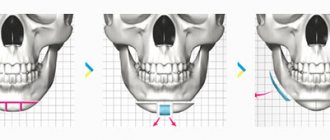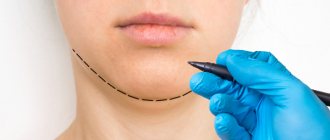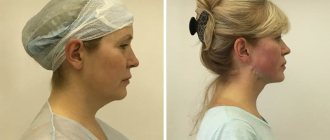Indications
♦ Underdeveloped chin from birth ♦ Age-related changes in the face
If the first group of evidence, as a rule, does not raise questions, then the second may provoke confusion. Indeed, with age, the volume of tissue in the lower part of the face increases. Why make this worse?
The fact is that during a facelift we move the soft tissues of the face upward, to their original, youthful position, and then the age-related decrease in the volume of the lower jaw becomes obvious. Many people do not like this emerging disproportion. This is why implant placement often significantly improves the outcome of surgical facial rejuvenation. This improvement is visible when viewed from the front and especially when viewed in profile. Moreover, sometimes if there is insufficient bone support without a chin implant, it is difficult to obtain a lasting good result from neck plastic surgery.
Chin surgery
Mentoplasty is a plastic surgery aimed at correcting the shape and size of the chin. Reconstruction is carried out by changing the contours, as well as reducing or increasing the parameters of the chin. This part of the face is formed from subcutaneous fatty tissue, lower jaw bone and skin. The shape and size of the chin significantly affects the perception of a person’s appearance as a whole. If this part of the face is too small or large and does not harmonize with the patient’s appearance, then mentoplasty will correct the situation.
Prices for chin surgery
Operation
Price
Mentoplasty
from 220,000 rub.
Attention! Professor Blokhin does not perform chin surgery. This operation is performed by other surgeons at the clinic.
Indications and contraindications for mentoplasty
Indications for plastic surgery to correct the chin will be:
- violating the proportions of the face, too small a chin;
- chin sloping to one side;
- protruding (massive) middle part of the lower jaw;
- “double” chin associated with age-related ptosis (sagging) of tissues;
- defects due to injury;
- congenital defects;
- patient's dissatisfaction with his appearance.
A plastic surgeon can modify the chin by installing a custom-designed silicone implant or using an autograft. For example, during rhinoplasty (nose job), the surgeon takes cartilage from the hump area. After this, he installs the resulting autograft in the chin area. If the chin is too small, a silicone implant is implanted. This way the profile is leveled and improved, and an overall harmonious appearance is achieved.
A chin can be reduced by an oral and maxillofacial surgeon who works with the bony structures of the face. This area of surgery is called gnathic (gnathic). As a result of the operation, even the most complex cases are corrected (grade 3). Recovery after surgery involves taking liquid food for about 1 month, as well as the possible need to wear braces. Mentoplasty cannot be performed in the presence of inflammatory processes in the lower part of the face, acute diseases of the internal organs and bleeding disorders.
Types of chin plastic surgery
There are two types of mentoplasty:
- Increasing the size
In this case, the bone bridge is raised or an implant is implanted. Silicone or cartilage tissue from the patient is used. In the latter case, the prosthesis is made during surgery. In other cases, it is prepared in advance. - Reducing the size
A large bone bridge is removed to eliminate the defect of its excessive protrusion. This is done by cutting the jawbone, moving its lower part back. There will be no stitches left on the face, as the surgeon works through the inside under general anesthesia.
The use of silicone is justified by its hypoallergenicity, it does not cause rejection and does not provoke any pathological reactions.
In case of a defect associated with the accumulation of adipose tissue under the skin and the formation of a double chin, liposuction is performed on this part of the face. Platysmoplasty is possible - an operation to tighten the muscles and skin in the neck area.
Preparation for mentoplasty surgery
Before performing chin contouring on a patient at the clinic of Professor S.N. Blokhin. An examination is prescribed to exclude side effects and the presence of contraindications. If necessary, the correctness of the bite is checked. If there are defects, surgery is prescribed to correct them.
Rehabilitation period
After the chin plastic surgery, the patient is observed in the hospital for a day. In the first days, swelling, difficulty chewing, and changes in sensitivity may appear. The pain is easily relieved with painkillers. During the rehabilitation period, the following rules should be followed:
- take antibiotics prescribed by the surgeon;
- use a chin support tape;
- rinse your mouth frequently with disinfectant solutions, as self-absorbable sutures must be clean;
- Until complete healing, take liquid or soft food.
When correcting the chin externally, the sutures are removed after 5-7 days. Patients return to work after examination by a doctor in about a week, unless the surgeon recommends otherwise. The result is noted immediately after rehabilitation. Chin plastic surgery is performed at any age, regardless of whether a man or a woman needs it.
Chin plastic surgery (mentoplasty) in Moscow | Operation technique and prices in the clinic of Professor S.N. Blokhin
Chin plastic surgery is aimed at correcting the shape and size of this area. Reconstruction is carried out by correcting the contours, as well as reducing or increasing the parameters of this part of the face.
Sign up for a consultation
Postoperative period
After installation of a chin implant, the patient experiences discomfort in the surgical area for 2-3 days. Painkillers successfully relieve them. There shouldn't be any severe pain! If you are experiencing severe pain after installing a chin implant, be sure to contact the surgeon who operated on you; perhaps the implant is not positioned correctly.
1-2 weeks after surgery, swelling occurs, associated with surgical trauma and the very fact of insertion of a foreign body. You don’t need to think at this moment that you have had an implant installed that is too large. The swelling will go away without a trace within 2 months.
Getting a chin implant is an operation you don't have to fear. It will not change your appearance radically. Your face will remain absolutely recognizable. The postoperative period proceeds in the same way as after most plastic surgeries, and averages 2 weeks. That is, in just 2 weeks you will enjoy changes for the better in the mirror!
| EVENT | HOW LONG AFTER THE OPERATION CAN THIS BE DONE? |
| To wash hair | 1 day |
| To drive a car | 1 day |
| Going to work | 3-7 days |
| Removing stitches | not required |
| Sex life | 1 Week |
| Sunbathe in the sun or in a solarium | 2 -3 weeks until bruises disappear |
| Fitness with a gentle load | 2 weeks |
| Pool | 2 weeks |
| Mandatory follow-up visit to the doctor | 1 week, 2 months |
A visit to a cosmetologist after surgical facial rejuvenation is welcome, but here there are certain restrictions. Before you begin the procedure, inform your cosmetologist that you have had surgery.
| EVENT | HOW LONG AFTER THE OPERATION CAN THIS BE DONE? |
| Lymphatic drainage facial massage | 3 days |
| Microcurrents | 3 days |
| Gentle cosmetic care, without mechanical cleaning | 10 days |
| Botox or Dysport injections | 1 Week |
| Peeling | 1 month |
| Face massage | 1 month |
| Laser resurfacing | 1 month |
| Injections of hyaluronic acid preparations | 6 months |
Indications for mentoplasty
Operation Mentoplasty is indicated for patients in cases where:
- asymmetrical chin shape;
- deformation of the tissues of the lower third of the face caused by trauma, or a congenital defect of the chin;
- double chin;
- violation of facial harmony due to disproportionate chin size;
- weakness of the chin tissue;
- a chin that juts sharply forward.
In most cases, patients who do not have pronounced aesthetic defects in the chin come to the plastic surgery clinic. But if this part does not correspond to the overall harmony of the face, which has led to the formation of complexes and psychological problems in the patient, then the plastic surgeon recommends, for example, reduction mentoplasty.
Rehabilitation after mentoplasty
The next day after chin mentoplasty, the patient is discharged from the clinic. The early period of rehabilitation is characterized by moderate pain, while swelling, which causes discomfort, does not allow us to evaluate the final result of the operation. Bruising, which is a rare phenomenon during mentoplasty, since a deep detachment is performed, usually disappears within two to three weeks. However, due to soft tissue detachment, a temporary change in articulation and loss of sensitivity in the operated area is possible. Their recovery may take several months.
When performing mentoplasty, access to the problem area is possible through the skin or through the oral mucosa.
In both cases, the sutures are not removed because the surgeon applies absorbable material. Moreover, if access was made through the mucous membrane, it requires special care - treatment with antiseptics, since the mouth contains aggressive microflora that can provoke infectious complications and inflammation.
To speed up healing, physiotherapy should be carried out with a rehabilitation specialist, who will draw up an individual rehabilitation plan. In addition, it is important to consider that recovery after osteoplastic surgery takes longer than with implant placement, because the volume of injured soft tissue increases.
Features of the operation
Chin correction can be performed in one of several ways - it all depends on what result you plan to ultimately achieve. Basic techniques:
- chin augmentation by installing an implant (implants made of synthetic material Porex are used)
- chin reduction by removing or pushing back a protruding bone fragment and then fixing it
- local correction of small defects (for example, asymmetry) using lipofilling (a technique that involves using the patient’s own fat tissue to increase volume in the area of correction)
Options for accessing tissue may also vary.
- The first option is classic - the incision is made from the outside, under the lower jaw
- The second option is less traumatic and does not leave visible scars later - the incision is made from the inside, on the mucous membrane of the lower lip
The optimal type of access and correction technique are determined strictly individually - during a consultation, together with a plastic surgeon.
Plastic surgeon Ksenia Avdoshenko is a highly qualified specialist with an impressive experience in the field of plastic surgeries of varying complexity. In order to bring your dream of an ideal appearance closer, take the first step - sign up for a consultation with Ksenia Evgenievna Avdoshenko right now.
Mentoplasty: rehabilitation and complications after surgery
After plastic surgery, a compression bandage is placed on the patient's face. It reduces tissue swelling and fixes the new shape of the chin.
External seams are treated with an antiseptic, which avoids infection of the wound.
Reviews of mentoplasty from patients who underwent surgical correction of the chin at Dr. Osin’s plastic surgery clinic indicate that after the intervention the following may occur in the area of the operation:
- pain and discomfort;
- loss of skin sensitivity;
- burning tissue;
- feeling of tension.
Do not be alarmed, as these phenomena are a normal reaction of the patient’s body to surgical intervention.
Strict adherence to rehabilitation rules will allow you to avoid complications after plastic surgery on the chin. After mentoplasty you must:
- reduce the load on the lower third of the face;
- eat food only in liquid or pureed form;
- give up physical activity and sports;
- limit visits to the bathhouse, sauna, solarium;
- refuse tanning.
Hematomas and swelling of tissues after mentoplasty in patients disappear within 5-7 days. The patient will be able to return to a full life 30 days after the operation.
Patients will be able to evaluate the results of mentoplasty before and after surgery in a couple of weeks if the chin was reduced during surgery. With augmentation mentoplasty, the result will appear in 3-4 months.
The seams when using the SMAS technique remain invisible. Traces of surgery can only be seen by plastic surgeons.








